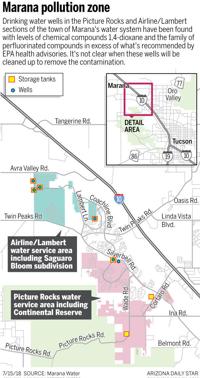Faced with public outrage over news of well-water contamination, Marana Town Council members are united in calling for the construction of aggressive water-treatment facilities, no matter the price.
“Cost is not the most important issue,” Mayor Ed Honea said during a council study session Tuesday night. “We’ll figure out the financing down the road. ... We’re going to do whatever it takes.”
The council directed staff members to produce a report by early October detailing the estimated cost of the project and looking at funding options.
Staff will also begin the procurement process of finding someone to design the treatment facilities, which would deal with water from the two Marana water systems affected by the contaminants, Town Manager Jamsheed Mehta said after the meeting.
The polluted wells serve more than one-third of the Marana water utility’s customers.
The unanimous support for new water-treatment systems seemed to defuse anger from some members of the public who spoke at the end of the meeting. Most thanked the council for recognizing the urgency of the situation but emphasized the need to stay vigilant.
“Keep the decisiveness going,” said Continental Reserve resident Jack Ferguson, adding that the issue is personal. He said his daughter was discharged from the Air Force with a disability due to chemical exposure in her living area.
“This is an emotional issue for me,” he said.
One of the pollutants is the industrial chemical 1,4-dioxane, which is used to stabilize common industrial solvents. Groundwater on Tucson’s south side is contaminated with the chemical and cleanup is underway. The other pollutant is part of a class of compounds known as per- and polyfluoroalkyl substances, known as PFAs. Those have polluted two drinking wells just north of Davis-Monthan Air Force Base.
Mehta estimated the cost of building the water-treatment plant would be $12 million, plus an additional $3 million to operate it for 20 years at current water-demand levels. Capacity would need to be expanded in the future as the town, and water demand, continues to grow, he said.
But some members of the public who spoke insisted the council had already delayed too long in taking action. Water utilities director John Kmiec emphasized the changing regulatory landscape and the risk of pursuing one solution, only to be confronted by a new regulation that could alter the town’s water-treatment goals.
Kmiec raised other possible solutions, including securing extra water from Tucson Water to blend with the contaminated well water in order to dilute contamination levels. But Tucson Water is currently limited in excess capacity after closing some of its own wells that were also polluted, Kmiec said.
Vice Mayor Jon Post floated the idea of a sales tax, if needed, to help fund the project. A one-tenth of a percent sales tax would generate $1 million a year, he said.
Marana Water Department officials have known since late 2016 that there were chemical pollutants in the water at levels exceeding Environmental Protection Agency recommendations. They notified Marana Water customers at the time.
Municipalities across the country are identifying these and other contaminants in their water supply, and testing in Marana was done out of curiosity since the issue has been cropping up nationally, Kmiec said.
The contaminants are present in everyday consumer products, including detergents, stain-resistant carpet and the lining of microwavable popcorn, and those products contribute to water contamination, Kmiec said.
“This is not a Marana issue,” he said. “This is a regional issue, this is a national issue.”






